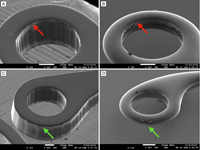Late dislocation of the capsular bag–intraocular lens–modified capsular tension ring complex after knotless transscleral suturing using 9-0 polypropylene
Main Article Content
Abstract
We report a case of late breakage of a 9-0 polypropylene transscleral suture used for fixation of a dislocated capsular bag–intraocular lens–modified capsular tension ring complex in a 52-year-old woman with Marfan syndrome. Breakage occurred despite use of a cow-hitch technique for external and internal fixation. We believe breakage was caused by the suture chafing on the sharp edges of the modified capsular tension ring eyelet. Cross-sectional analysis of Malyugin-modified capsular tension rings from two different manufacturers revealed a difference with respect to radius of curvature. Suturing intraocular implants with relatively sharp edges may cause suture breakage; further studies are needed to identify the critical parameters for the surface quality of sutured intraocular implants.
Downloads
Article Details

This work is licensed under a Creative Commons Attribution-NonCommercial-NoDerivatives 4.0 International License.




